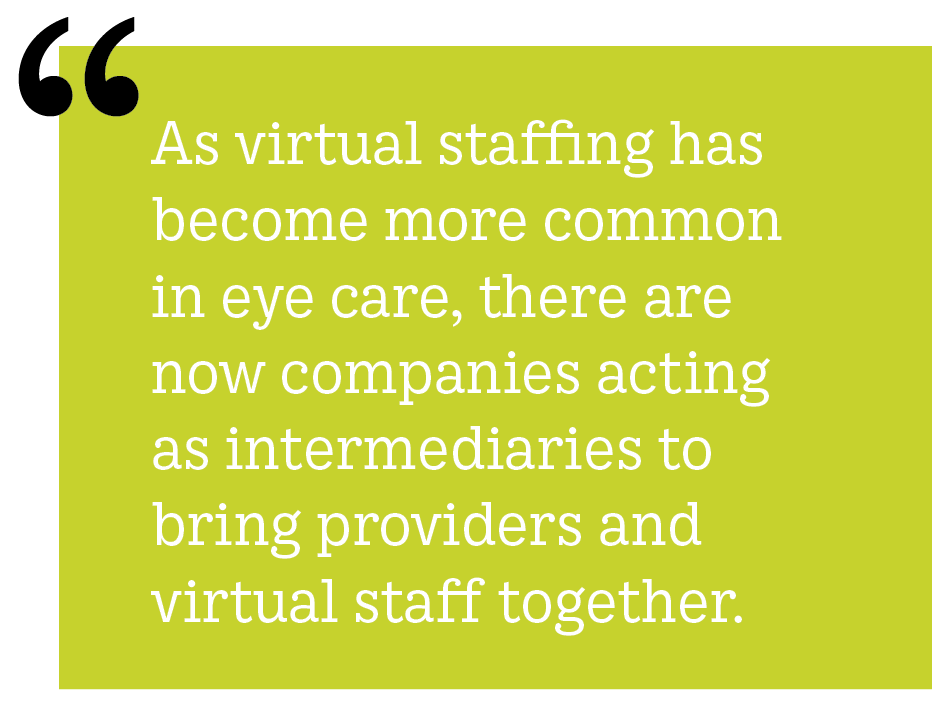Virtual staff: Is it time to make the leap?
Understanding the role of virtual staff and considering the pros and cons.
When difficulties arise with finding and/or hiring qualified staff, or when staff costs need to be contained for a particular position to remain competitive or to free up cash flow to fund equipment purchases or raises for other in-person staff, the virtual staffing option should be strongly considered. (Adobe Stock / insta_photos)

There’s no denying the workforce transformation that occurred when the COVID-19 pandemic reared its ugly head. Health care has certainly not been immune to these changes, and while rural clinics have traditionally been more insulated from short-term labor trends than their suburban and urban counterparts, even they have experienced higher staff turnover and more hiring challenges over the past 3 years. In fact, staffing tops the list of anxieties for the health care industry at large this year, with the US health care industry alone losing more than 500,000 employees each month in 2022.1
In 2022, staff turnover within health care ranged from 19.5% in hospitals (down from a high of 26% in 2021) to 65% for at-home care providers and 94% at nursing homes.1 Labor workforce shortages exist internationally as well,2 with staff turnover causing significant financial burdens and creating impediments to care for both large and small health care clinics alike.
Not surprisingly, most eye care practices have seen their fair share of staff turnover post–COVID-19, too. While numbers within eye care are a little harder to quantify, hiring and retaining quality staff continue to be front and center for most clinics.
More than ever, hospitals and larger health care networks seem to be dipping into the eye care space for new hires, making it more challenging and more expensive for practices to adapt, while forcing nontraditional solutions to be considered.
While various definitions of the word “virtual’ exist, Merriam-Webster defines it several ways:
» very close to being something, without actually being it; or
» being on or simulated on a computer or computer network.3
To that end, we’re familiar with virtual reality, virtual environments, virtual classes, virtual exams, virtual tours, virtual courses, virtual libraries, virtual wallets—but virtual staff? What is that?
What is a virtual staffer?
Virtual staff are typically experienced, independent contractors who provide administrative, clerical, and/or professional services to clients for 30 to 40 hours per week, all while being located outside the client’s physical office. They work remotely but have access to the organization’s online portal and resources.4
As virtual staffing has become more common in eye care, there are now companies acting as intermediaries to bring providers and virtual staff together. Some of these companies even advertise extensive experience with common electronic health records used in eye care, ophthalmic practice management software, and even tout billing expertise with many vision and medical insurances.

Before we go any further, let me state that whether seeing patients as an associate, an independent contractor, or an owner, my experiences in our profession have consistently reinforced the critical role that in-person staff play in providing great eye care. We could never do what we do without the support of a wonderful team of health care personnel. From front office duties such as check-in/receptionist, file clerk, insurance verification staff, checkout staff, and billing specialist; to clinical staff roles such as technician, scribe, optician, or doctor; to administrative roles such as office manager, practice administrator, optical manager, or administrative assistant, our staff can make or break a clinic.
A well-trained, efficient, cohesive team can make the busiest of days profitable and still flow smoothly, whereas the opposite can make the most average of days less profitable and simply miserable (for doctors, patients, and fellow staff alike). Because of the critical role staff play, staffing decisions should not be taken lightly. Among numerous other considerations, determining whether to go with virtual or in-person staff for any position may vary depending on the practice’s demographics (a younger, more tech-savvy patient base may be impressed by virtual staff, while an older, more traditional patient base may prefer in person).
Common virtual staff positions
Virtual assistants: can manage email accounts, coordinate projects, conduct research, manage/post on social media accounts, edit documents, manage schedules/calendars, perform light bookkeeping duties, arrange travel, manage/monitor websites, etc.
Virtual receptionists: can answer phones, make/return phone calls, handle patient referrals (incoming and outgoing), manage appointments, refill prescriptions, verify insurance, complete other clerical tasks, etc.
Virtual medical billing assistants: can obtain preauthorizations for exams and procedures, verify insurance eligibility, answer patient billing questions, organize financing or payment plans for patients, submit insurance claims, organize financing or payment plans for patients, etc.
Virtual scribes/techs: can remotely listen to the conversations between the doctor and their patients, enter transmitted and/or verbalized clinical data into the electronic health record, follow up with patients as needed, and e-prescribe medication requests, among other tasks.
Using the aforementioned definitions of “virtual,” these virtual staff use a computer network to simulate traditional, in-person staff, without actually being in-person staff.
Virtual staff considerations
Pros: Costs for virtual staff range roughly from $500 to $1400/month, depending on the individual staffer’s experience, position, and work duties. Since the virtual staffer is an independent contractor, there are no benefits or payroll taxes paid by the clinic, resulting in up to 70% savings vs a traditional W-2 payroll employee. Virtual staff can still be vetted and interviewed, just like an in-person employee, and if things don’t work out, it is much easier to transition to other options without incurring unemployment claims.4
Cons: There is no in-person face-to-face time with the staffer, which may negatively affect communication and accountability in some instances. Because the staffer is not a W-2 employee, there may be less incentive for the staffer to be loyal to the practice. Additionally, if technical problems arise with internet service/access, software, and/or hardware, the staffer may be unable to perform their duties, severely impacting clinic activities.
Conclusion
Make no mistake about it, I’m still in favor of efficient, highly trained, in-person staff. But when difficulties arise with finding and/or hiring qualified staff, or when staff costs need to be contained for a particular position to remain competitive or to free up cash flow to fund equipment purchases or raises for other in-person staff, the virtual staffing option should be strongly considered. Here’s to your virtual success!
References:
1. Lindquist M. The real costs of healthcare staff turnover. Oracle. March 22, 2023. Accessed August 1, 2023. https://www.oracle.com/human-capital-management/cost-employee-turnover-healthcare/
2. Talent disruption: strategic workforce planning in the age of labor shortages. Harvard Business Review. July 12, 2022. Accessed August 1, 2023. https://hbr.org/sponsored/2022/07/talent-disruption-strategic-workforce-planning-in-the-age-of-labor-shortages
3. Virtual. Merriam-Webster. Accessed August 1, 2023.https://www.merriam-webster.com/dictionary/virtual
4. Kenton W. What is a virtual assistant, and what does one do? Investopedia. Updated June 4, 2023. Accessed August 1, 2023. https://www.investopedia.com/terms/v/virtual-assistant.asp

Newsletter
Want more insights like this? Subscribe to Optometry Times and get clinical pearls and practice tips delivered straight to your inbox.